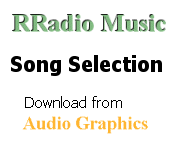| Tuesday, August 13, 2013 |  |
 |
 |
 |
 |
 |
 
 
 |
 |


 A New Breed of Indie Artists
A New Breed of Indie Artists Free Music and Programs for Radio and Podasters
Free Music and Programs for Radio and PodastersProgramming for Internet Radio Industry
|
Despite claims heard within the broadcast radio industry - e.g., 93% of the U.S. population listens to radio at least once each week, broadcast radio features "local" programming, and DJs "curate" the music played - anyone who's remotely close to the situation knows the reality. The radio industry has been terribly slow at adapting technology for advertising accountability, site design, mobile, etc., leading youth to avoid terrestrial radio in larger numbers than just a few years ago. |
"The internet radio industry needs help, which it can easily find through artist selection at RRadio Music and through choices offered by "Intro to Indie Artists" programs. All are free. Artists sign waivers on royalty payments." |
Once the morphing of in-car dashboards is complete, audio's audience is up for grabs. If your radio station is online, is your programming ready for what's ahead?
You won't find many articles on how to program an online radio station, though programmers commenting on their stations are plentiful. When weeding through the words, notice how they are reflective of traditional radio industry positioning: "We play the best music," "(station) plays few(er) commercials," "...playing hits of the '70s, '80s, '90s," "Listen to (fill in the format) music from today's stars; etc.
My personal favorites are the ones requesting "Like us on Facebook" or "Share us with a friend on Twitter." These are posted with great expectations, followed by even greater disappointment. Calls to action like this don't work for a simple reason: There is so much audio programming today that being a standout radio station takes far more time than most internet radio industry programmers have.
Let's ask the magic questions: 1) How is your programming different from that of competitors? 2) How do you make your station found? We'll tackle the former now; comments on the latter are coming soon.
Online audio entertainment and information are pervasive, ubiquitous through platform agnostics, and mostly boring in presentation. I'm aware of exceptions (which probably include your station), but hear me out.
There are thousands of internet stations attached to the broadcast radio industry, which get near-constant (local) promotion. A single internet radio station lacks this ability. The mentions of "iHeartRadio" ad nauseum by Clear Channel and its broadcast partners overshadow any self-promotion of services like Pandora, Slacker, LastFM, Live365, and Spotify combined. And iHearRadio is still only a blip on the internet radio radar.
To put this in perspective, iHeartRadio boasts over 1,500 stations. If individual online station audience numbers were made public, I'm confident you'd shake your head at the low numbers for any single station in its lineup. The reason? Stations are hard to find and most lack quality programming.
Creative programming is difficult to make and time consuming. Those who believe an online station can program to a specific geographic area while gaining enough of an audience to matter fool themselves. All "local" info they profess to deliver can be found within seconds, on demand, as stand-alone items on a smartphone, tablet or desktop.
|
Online requires "different" programs. Online radio demands interaction between station and audience. Internet radio, if it is to continually draw back listeners while attracting new ears, must present a combination of familiar artists with the new, programs which are not found in the broadcast sector, and brevity in content that makes a six-hour shift by one jock seem old fashioned. The internet radio industry needs help, which it can easily find through artist selection at RRadio Music and through choices offered by "Intro to Indie Artists" programs. All are free. Artists sign waivers on royalty payments. Each takes mere seconds to find, download, and schedule. |
  |
The option is to be old school radio on a new technological platform, or to create tomorrow's audio content using that same new technology. Which way do you lean?
The broadcast radio industry may appear a Goliath, but that's only for the moment. Its leaders are trying to maintain old school in a new world. Don't make the same mistake with your internet radio station.
Create new programs. It's the old style of radio that's pushing youth away from their parents' broadcasts.
You want to be out front when those new dashboards are installed in a majority of vehicles. It's at that time when the terrestrial radio industry will realize it waited far too long - proof is in how it caters more to the elderly with each passing year.
Today's indie artist introduction is to...
| Easy Listening artist Lisa Mowery |
 sample song |
I'm So Blue Download Song
|
Give Lisa Mowery's "I'm So Blue" a listen.
Add it to your playlist, free! Such is the new world of music distribution.
It's time internet radio programmers reach into a huge pile of untapped talent.
It is here where new hit songs will increasingly be found.
More Articles
 |
 |
 |
comments by Disqus |




